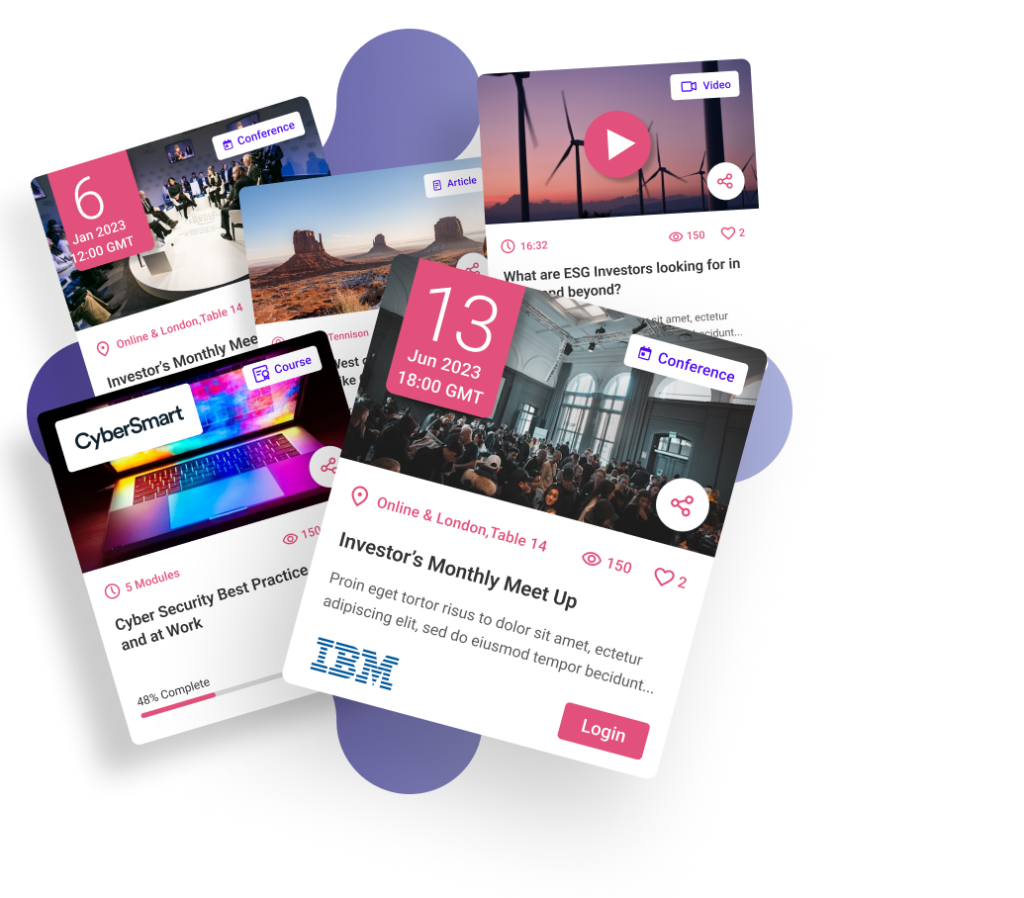
5 Ways to Use Smart Event Data to Create High-Value Audience Journeys
How corporate event planners can leverage event data to retain audiences and win more opportunities ...

Grappling with event data. Creating continuous digital audience journeys. Extending the lifecycle of your event. Smart events can seem daunting but that doesn’t have to be the case.
The good news is that smart events have a maturity model all of their own and there are easy entry points and low-hanging fruit if you know where to look. However, regardless of whether you are just starting out or using smart events to drive highly targeted event, community and marketing campaigns – getting your strategy right is essential.
Here’s our advice on how to create a successful smart event strategy as well as some hints and tips for easy entry points.
For a smart event to succeed it’s got to offer value to your audience, because of course they must be ready to dip their toe in the water and share data. A good place to start is working out who your key high-value personas are and assessing their priorities because smart events can save them time and get them directly to what they value.
For example, if your audience value networking it makes sense to consider algorithmic networking on your mobile event app, allowing them to create their own interest tags and see recommended connections with subject experts. However, it also might mean more radical steps like shifting some content to on-demand, creating more space in your agenda for networking. On the other hand, if your audiences value learning, smart events could offer them virtual ‘deep-dive’ workshops before or after the event, or even pop-up clinics based on trending topics or questions tracked before and during your event.
If you have time, analyse data on past audience behaviour and talk to a range of client-facing internal stakeholders or even survey your attendees to increase the chance of succeeding with your smart event. What you want to achieve is a balance of data capture points that are of interest to your organisation and those of interest to your audience.
Set achievable goals that align with your marketing strategy. For example, if your goals are to educate or persuade your audience about a certain topic, you could measure whether participants come away more knowledgeable or inclined to accept a belief statement on a certain topic with a poll at the start and end of the conference.
If we’re talking about an in-house corporate conference your goal might be lead generation or client intelligence. You could aim for a certain number of meetings booked onsite with new, qualified prospects or existing clients. But you could also think slightly longer-term. For example, your goal might be to build a large enough database of people interested in a new product or service you offer, based on their digital behaviour at your event – perhaps people who downloaded your core thought-leadership asset or checked into a particular session. This information can then be used in lead nurturing campaigns. Or a more ambitious target might be to pre-plan post-event follow-up webinars around one or two key topics and aim for a third of your audience with matched interest tags to attend.
If you’re a commercial events company your goals are likely to be based on performance data and sponsor re-bookings. This might translate to taking a certain number of rebookings onsite, aided by real-time data showing content downloads and booth visits to help sponsors measure success. Or even being able to upsell a new spin-off event opportunity using behavioural data to identify a trending topic and group of people interested in it.
Sit down with marketing departments or fee earners to negotiate what data would be most helpful to collect for downstream campaigns or even to get in real-time to support conversations during the event. You might have your own goals for tracking event performance, but ideally, at least some of these should directly align with other departments.
Do you need to track interest in several market verticals or geographic locations? Do you need to track trending topics, or see which individuals are attracting the most meeting requests? Do you want to analyse data by job title, company, account type etc?
Consider how you plan to leverage real-time data, especially if you have sponsors or partners. If your lead sponsors have lower-than-expected leads, you could use live event data to identify this early on and suggest booth re-adjustments, more push notifications, social media promotion or mentions from event hosts.
This is such an important step for smart events because it enables you to determine content popularity and lay your breadcrumb trail to maintain interest after the event. Think about how topics can be grouped under common pain points as well as learning points – or ask your audience what their pain points are. Why? If you do plan to run follow-up events, workshops or campaigns, focusing on a particular pain point can help improve lead conversion.
Ideally, you want to get to the point where you have clearly tagged lists of content that people can be assigned to when they watch a virtual session or check into a theatre in-person, or scan a QR code.
If you are making content available on-demand, break longer pieces up so your audiences can find what they are looking for, while you can get a more granular view of exactly what they are zoning in on. Finally, if you have a diverse audience interested in multiple topics, take one key interest area first and build out a content plan around it – particularly if you have a more ambitious goal of creating a community.
Think about your user journey and avoid asking delegates to complete huge amounts of data at any one time – particularly during registration. Consider how you want your audience to explore your content – could some of it be held back for a spin-off event or webinar? If you have case studies, reports or news articles linking to the topic, make these available in the on-demand area or a digital community if you are planning to create one.
Plan a short sequence for interaction – perhaps encourage your audience to network on their mobile, complete a poll during a session and download a report highlighted. Once you are comfortable add on spin-off sessions such as joining a follow-up deep-dive webinar or even send invitations to a specific community.
You should also build in a degree of flexibility so your audience can interact with content in different ways. Give them options to see different content on landing pages or access it at different points within the event lifecycle. Some might not want to scan a QR code at the end of a session for example but may download content from an email link post-event. If you are able, offer them a choice of formats video, pdf, article etc. and different angles on your topic, so they get an understanding of what deeper engagement can offer.

Getting buy-in from your speakers, sales team and senior leadership at the event is essential. If you’re using a mobile app, clearly communicate the value of your new engagement feature to your audience in the email communications in the run-up to the event – ask your event tech partner if they can help you create promotional videos.
Encourage your speakers and moderators to reference the app during their time on stage and plan how they will fill time while they are waiting for virtual and/or in-person audiences to do things, such as complete a poll.
Clearly define the value of each feature, for example – if you are using in-session messaging, explain to your audience it is designed to enable them to find and connect to subject experts in the room.
Pick your milestones for review in advance and make sure you create enough time to properly analyse the data. Bear in mind that you might want one of these checkpoints to be during the event itself if you have planned to make changes on the fly.
Ideally, make sure you have all the data in one place and in one format so you can easily draw conclusions. And don’t forget to elicit feedback from your audience – if you want them to continue sharing data and even contribute to content in future, they must feel like their voice is heard in the process.
However you decide to approach smart events, make sure you pick a tech provider who can offer strategic guidance as well as enterprise-level support; a partner who understands your objectives and most importantly, matches your vision for growth.
You are unlikely to need every possible smart event feature right now, but you do want to future-proof your tech investment so that you can be ready to easily switch on new features as required.
After all – your next event idea might just hinge on it.
————————————————————————————————————————–
For tailored advice about how your company might advance up the smart event maturity ladder, book a smart events workshop with the Totem team today.
Our team of specialists are ready to help you shape your perfect engagement ecosystem.
020 7700 3632 hello@wearetotem.io 8 Hornsey StreetBy submitting this form, you are agreeing to Totem’s Privacy Policy and Cookie Policy.